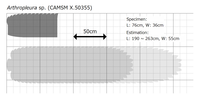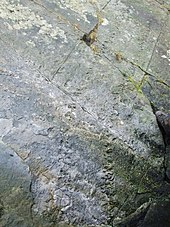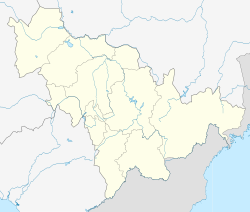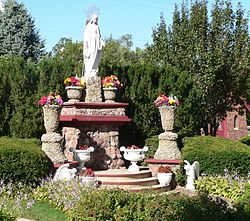Arthropleura
Arthropleura| Arthropleura 시간 범위: 초기Viséan-Sakmarian, 345–290 엄마 PreꞒ Ꞓ OSDCPTJKPg N. | |
|---|---|
 | |
| 화석은 Senckenberg 박물관 프랑크푸르트에서 A.armata. | |
 | |
| a.armata의Diagrammatic 회복이었다. | |
| 과학적 분류 | |
| 왕국: | 애니멀리아 |
| Phylum: | 절지 동물문 |
| Subphylum: | 다지류 다족강 |
| 등급: | 노래기류 |
| 순서: | †Arthropleurida Waterlot, 1933년 |
| 패밀리: | †Arthropleuridae 치텔, 1885년 |
| 속: | †Arthropleura 마이어, 1854년 |
| Species[1] | |
| |
| 동의어 | |
| |
아르스테로플레우라(Arthropleura, 그리스어 for jointed ribe)[1][3]는 3억4,500만 년 전 현재 북미와 유럽에 살았던 멸종된 밀리페데 절지동물의 속이다.[1][2] 이 속종의 종은 역사상 가장 큰 육지 무척추동물이며, 만약 있다면 포식자가 거의 없었을 것이다.
형태학
아르트로플레우라는 길이가 약 0.3미터(1피트 0인치)에서 2.5미터(8피트 2인치)인 아르마타까지 다양했다.[4] 노바스코샤 주 조긴스에서 최대 50 센티미터(20인치) 폭의 아스트로플레우라 자국이 발견되었다.[5] 2021년에 화석이 보고되었는데, 아마 폭은 55 센티미터(22인치)이고 길이는 1.9 미터(6피트 3인치)에서 2.63 미터(8피트 8인치)인 아스트로플레우라의 외골격일 것이다.[2][1] 아르스테로플레우라는 현대의 절지동물보다 더 크게 자랄 수 있었는데, 부분적으로는 그 당시 지구 대기의 산소의 부분압력이 더 컸고, 육지 척추동물 포식자가 많지 않았기 때문이다.[6]
아르스테로플레우라는 잘 발달한 테르기이트(등뼈 외골격)가 3엽처럼 세 개의 로브를 가지고 있으며 등뼈 표면은 많은 결핵으로 덮여 있는 것이 특징이다. 이전에 머리 방패라고 생각했던 첫 번째 삼엽산 테르기이트 앞의 앞 타원형은 후속 연구에 의해 콜럼(밀레네 트렁크의 첫 테르기이트)으로 간주되었기 때문에 머리는 거의 알려져 있지 않다.[7][8] 다른 절지동물(Microdecmplex)에서 발견된 것에 근거하여, 머리에는 비필름성 더듬이와 트럼펫 같은 장기가 있을 수 있다.[9] 아르트로플레우라는 28에서 32에 이르는 3엽산 테르기이트를 가지고 있었던 것으로 추정된다.[1] 다리와 테르기이트의 정렬은 잘 이해되지 않지만 적어도 현대의 밀리페데처럼 테르기이트당 두 쌍의 다리처럼 어느 정도 복엽적인 것으로 여겨지고 있다.[9][8] 중앙선미대 옆에는 각 다리 쌍 주위에 K-, B-, 로제트 판 등 복측 판 3쌍이 놓여 있었고, B-플리트나 K-플리트 중 한 쌍은 호흡기관으로 되어 있었다.[7][8][10] 시체는 사다리꼴 텔슨으로 종결되었다.[8]
고생물학
아르트로플레우라 화석은 모두 사체 대신 외피(조개껍질)로 추정된다.[10] 얇은 외피, 다리 밑부분 주변의 버팀목 판, 그리고 3cm 깊이의 선로 화석이 잘 보존되어 있다는 것은 그들이 단단한[11][12] 외골격을 가지고 있고 땅을 돌아다녔다는 것을 보여준다.[1] 아르스테로플레우라는 한때 석탄 숲에서 주로 살았던 것으로 여겨졌다.[8] 그러나, 선로 화석이 더욱 개방된 지역에서 발견되었고, 카본리퍼스 우림이 붕괴된 이후에도 화석이 발견되었기 때문에 아마도 숲에 독립적인 삶을 살았을 것이다.[1]
한때 리코포드 파편과 피테리도피 포자 등 [13]코프로이트로 여겨졌던 화석이 나중에는 식물 화석과 엑수비아 유적의 공존에 불과하다고 여겨지기 때문에 아르트로플레우라의 식단에 대한 확실한 증거는 없다.[7] 그럼에도 불구하고 초식성 식단의 해석은 여전히 받아들여지고 있으며, 아스테로플레우라는 아마도 많은 영양분을 필요로 하는 거대한 크기에 근거하여 포자뿐만 아니라 과일, 산발성 식물, 씨앗을 섭취했을 것으로 추정된다.[10]
소멸
기존에는 아스트로플레우라가 멸종한 원인이 석탄산림 감소 때문인 것으로 추정된다.[14] 그러나 카본리퍼스 열대우림이 붕괴된 이후에도 많은 화석이 발견되어 아르트로플레우라 자체가 산림에 독립적인 생활을 한 것으로 추정된다. 이후 테트라포드의 다변화와 적도의 탈원화로 인해 멸종했을 가능성이 있다고 판단된다.[1][10]
참고 항목
참조
- ^ a b c d e f g h Neil Davies; et al. (Dec 21, 2021). "The largest arthropod in Earth history: insights from newly discovered Arthropleura remains (Serpukhovian Stainmore Formation, Northumberland, England)". Journal of the Geological Society. doi:10.1144/jgs2021-115. S2CID 245401499.
- ^ a b "Largest-ever millipede fossil found on Northumberland beach". BBC News. 21 December 2021. Retrieved 21 December 2021.
- ^ 로널드 L. 마르티노와 스티븐 F. Greb(2009년). '켄터키 주 상층부의 거대한 육지 절지동물의 산책로' 웨이백머신에 2019-12-23 보관 고생물학 저널. 2019년 12월 23일에 검색됨
- ^ George r. Mcghee, Jr (2013-11-12). When the Invasion of Land Failed: The Legacy of the Devonian Extinctions. ISBN 9780231160575.
- ^ "The Excitement of Discovery". Virtual Museum of Canada. Archived from the original on February 4, 2012. Retrieved 2006-04-17.
- ^ M. G. Lockley & Christian Meyer (2013). "The tradition of tracking dinosaurs in Europe". Dinosaur Tracks and Other Fossil Footprints of Europe. Columbia University Press. pp. 25–52. ISBN 9780231504607.
- ^ a b c Sues, Hans-Dieter. "Largest Land-Dwelling "Bug" of All Time". National Geographic. Ford Cochran. Archived from the original on 4 March 2016. Retrieved 14 February 2017.
- ^ a b c d e Kraus, O.; Brauckmann, C. (2003-05-05). "Fossil giants and surviving dwarfs. Arthropleurida and Pselaphognatha (Atelocerata, Diplopoda): characters, phylogenetic relationships and construction". Verhandlungen des Naturwissenschaftlichen Vereins in Hamburg. 40: 5–50.
- ^ a b Wilson, Heather M.; Shear, William A. (1999). "Microdecemplicida, a new order of minute arthropleurideans (Arthropoda: Myriapoda) from the Devonian of New York State, U.S.A." Earth and Environmental Science Transactions of the Royal Society of Edinburgh. 90 (4): 351–375. doi:10.1017/S0263593300002674. ISSN 1473-7116.
- ^ a b c d Schneider, Joerg; Lucas, Spencer; Werneburg, Ralf; Rößler, Ronny (2010-05-01). "Euramerican Late Pennsylvanian/Early Permian arthropleurid/tetrapod associations – implications for the habitat and paleobiology of the largest terrestrial arthropod". New Mexico Museum of Natural History and Science Bulletin. 49: 49–70.
- ^ Adrian P. Hunt; Spencer G. Lucas; Allan Lerner; Joseph T. Hannibal (2004). "The giant Arthropleura trackway Diplichnites cuithensis from the Cutler Group (Upper Pennsylvanian) of New Mexico". Geological Society of America Abstracts with Programs. 36 (5): 66.
- ^ D. E. Briggs; A. G. Plint & R. K. Pickerill (1984). "Arthropleura trails from the Westphalian of eastern Canada" (PDF). Palaeontology. 27 (4): 843–855. Archived from the original (PDF) on 2016-10-11. Retrieved 2016-09-22.
- ^ A. C. Scott; W. G. Chaloner & S. Paterson (1985). "Evidence of pteridophyte–arthropod interactions in the fossil record" (PDF). Proceedings of the Royal Society of Edinburgh. 86B: 133–140.
- ^ Thom Holmes (2008). "The first land animals". March Onto Land: the Silurian Period to the Middle Triassic Epoch. The Prehistoric Earth. Infobase Publishing. pp. 57–84. ISBN 9780816059591.
외부 링크
| 위키미디어 커먼즈에는 아르스테로플레우라 관련 매체가 있다. |
- Lyall I. Anderson; Jason A. Dunlop; Carl A. Horrocks; Heather M. Winkelmann; R. M. C. Eagar (1998). "Exceptionally preserved fossils from Bickershaw, Lancashire UK (Upper Carboniferous, Westphalian A (Langsettian))". Geological Journal. 32 (3): 197–210. doi:10.1002/(sici)1099-1034(199709)32:3<197::aid-gj739>3.0.co;2-6.







